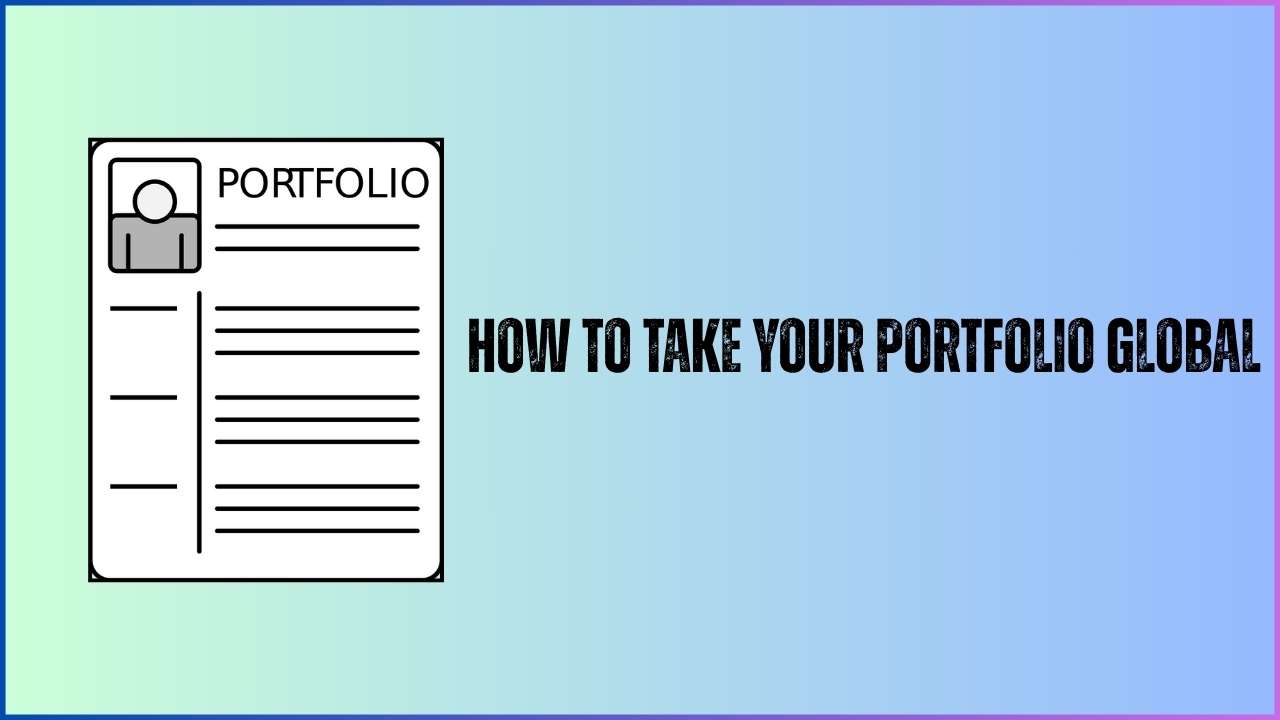Investing sensibly involves diversifying your money into various assets such that if one investment performs badly, others may remain good. An old adage in investing is: “Don’t put all your eggs in one basket.” This principle is still valid today. Whereas most Indian investors invest in local stocks, bonds, or property, investing in international (global) securities in your portfolio can add additional stability, greater returns, or both.
But making your portfolio global is not as easy as purchasing a couple of foreign shares. You must prepare, learn, and know how various markets operate. This guide will outline step by step how to globalize your portfolio, in plain language and down-to-earth tips.
Why Go Global?
- Reduce Risk
Investing in multiple countries minimizes the probability of all your investments going in the same direction simultaneously. For instance, if the Indian stock market declines, the market of some other country may be on the rise. - Better Returns
Some foreign industries or businesses will expand more rapidly than Indian businesses. Investing overseas allows you to access fresh opportunities you may never have at home. - Currency Benefits
When you hold assets in a foreign currency, you benefit if the currency appreciates against the rupee. Naturally, you lose on currency too if the rupee appreciates. Nevertheless, a combination of currencies can counter these fluctuations. - Diversification Across Sectors
Some industries, such as technology or health care, may be more advanced overseas than in India. Investing abroad allows you to add these industries to your portfolio more conveniently.
Things to Do Before Taking Your Portfolio Global
Before you start buying foreign stocks or funds, consider the following steps:
1. Research
- Gather Information: You can learn about the firms, funds, or markets you’d like to invest in. Although you reside in India, you can utilize online resources to find research reports on numerous foreign firms.
- Understand Supply and Demand: Whether you buy stocks, commodities, or real estate, you need to know how supply and demand work in that market. For example, if a tech company abroad is releasing a popular new product, demand for its stock might rise.
- Know the Region’s Sectors: Each country or region has different industries that drive its economy. For instance, the U.S. has a strong tech sector, while some European countries might be known for manufacturing. Understanding these differences helps you choose wisely.
- Back Up Your Decisions: Always ask yourself why you are buying a particular asset. Your investment decisions should come from solid information, not just a hunch.
2. Put Your Feet on the Ground
- Learn the Local Context: You might be able to trade commodities or stocks from your desk in Mumbai or Delhi, but if you do not understand how things work on the ground—like how local regulations affect trading or who the main buyers of a commodity are—you may miss important clues.
- Stay Informed About News: Currency rules, political events, or even weather can affect foreign investments. For instance, a drought in a country that produces a certain agricultural commodity can push prices up.
- Get Comfortable with Instruments: Make sure you understand exactly what you are buying. Is it a stock, a futures contract, or a fund? Each instrument behaves differently, so know its pros and cons before you invest.
3. Understand the Nuances of Foreign Markets
- Different Data, Different Impact: In the U.S., job reports (like nonfarm payroll numbers) can move stock prices strongly. In India, similar data might not always have the same effect on markets. Learn which data points matter in each country you plan to invest in.
- Watch Out for Extra Risks: Foreign markets can be riskier if you do not know the language, regulations, or local customs. Always balance the potential reward with the added risk.
4. Search for Local Partnerships
- Use Local Banks and Brokers: If you open a foreign brokerage account or trade currencies (Forex), it’s helpful to have a local bank or broker in that country. They can help you transfer money quickly and with fewer fees.
- Electronic Banking: Transferring funds between India and another country is easier than 10 years ago, thanks to electronic banking. Still, having reliable partners in each country can save you time and money.
- Note: For trading foreign stocks from India, you do not need to open an overseas bank account. You can use your regular DEMAT and trading account in India if your broker has tie-ups with a foreign brokerage.
5. Keep Your Investments Diversified
- Multiple Markets, Multiple Advantages: If you trade in several markets, you can move money to whichever market looks most active. For example, if European markets are strong this quarter but U.S. markets look weak, you can focus on Europe for a while.
- Similar Protection at Home: If you prefer to stay in Indian markets, you can still diversify within India using different sectors, asset classes (stocks, bonds, real estate), and investment styles (growth, value, dividends). This helps protect against big swings in any one segment.
6. Consider Your Investment Horizon
- Timing Matters: Global markets run on different time zones. The New York Stock Exchange (NYSE) operates when India is in early morning hours. If you want to trade U.S. stocks, you need to be aware of the time difference.
- Long-Term View: Generally, international investments reward patient investors. A well-researched position in a stable foreign company or fund is more likely to grow steadily over years rather than provide quick, short-term gains.
- Monitor Regularly: Even if you invest for the long term, you should check your international holdings from time to time. Economic or political changes abroad can affect your returns significantly.
How to Invest in International Markets
Once you have done your homework, you can choose among several routes to invest abroad.
1. Direct Stock Investment Through Brokerages
- Open a Foreign Brokerage Account: Many online platforms now allow Indian investors to open a foreign brokerage account easily. You can buy stocks listed on the NYSE, NASDAQ, London Stock Exchange, and more.
- Use Indian Brokers with Tie-Ups: Some Indian brokers have partnerships with overseas brokerages. In this case, you can use the same DEMAT and trading account you already have to buy foreign stocks.
- Points to Note:
- Liberalized Remittance Scheme (LRS) Limits: Under LRS, an Indian resident can remit up to USD 250,000 per financial year (April to March) for investments and other permissible transactions. Keep this limit in mind when planning your global investments.
- Currency Exchange Risk: If you buy a stock for USD 100 when 1 USD = 80 INR, you pay 8,000 INR. If the rupee later strengthens to 75 INR per USD while the stock’s price stays at USD 100, your investment’s rupee value falls to 7,500 INR. Always remember that exchange rate changes can boost or reduce your returns.
- Fractional Share Investing: Many international platforms let you buy a fraction of a share. You might buy just 0.01 or 0.001 of an expensive U.S. stock. This lowers the entry barrier for high-priced stocks.
- Due Diligence: Before you start:
- Compare brokerage charges, forex fees, and transaction costs.
- Check if the platform provides research tools, margin facilities, and support in case of any issues.
- Read user reviews to make sure the platform is reliable and secure.
2. Feeder Funds / Fund of Funds (FoF)
If you want international exposure without picking individual stocks, consider mutual funds that invest abroad.
- What Is a Feeder Fund?
A feeder fund, or fund of funds, is a domestic mutual fund that pools your money and then invests it in an overseas mutual fund or index fund. For example:- Franklin India Feeder – Franklin U.S. Opportunities Fund: When you invest in this feeder fund, your money goes into Franklin’s U.S. fund, which holds a portfolio of U.S. stocks.
- International Index Feeder Funds: Some feeder funds track global indexes like the S&P 500 or Dow Jones, giving you broad exposure to large U.S. companies.
- Points to Note:
- No LRS Limits: Since you invest in rupees and the domestic fund converts and invests abroad, you do not hit the USD 250,000 cap directly.
- Higher Expense Ratios: You pay fees both to the Indian fund manager and the overseas fund manager. This can mean a higher overall expense ratio than a purely domestic mutual fund.
- Ease of Use: You can buy these funds through your regular mutual fund account—no need for a separate brokerage. They are simple to add to your portfolio if you prefer a “set it and forget it” approach.
3. Forex Trading (Foreign Exchange)
- What Is Forex?
The forex market is where you trade one currency for another, for example, buying USD with INR or EUR with INR. It is the most liquid market in the world because businesses, investors, and governments need foreign currency for trade and investment. - Why Trade Forex?
- Hedging: If you have foreign currency expenses (like paying tuition abroad), you can lock in an exchange rate ahead of time.
- Speculation: By predicting whether a currency pair (e.g., USD/INR) will go up or down, you can try to earn profits based on exchange rate changes.
- Diversification: Holding a small portion of your portfolio in forex can help smooth out returns if stock or bond markets in India or abroad move against you.
- What Affects Forex Prices?
- Interest Rates: Countries with higher interest rates often attract foreign capital, strengthening their currency.
- Geopolitical Events: Elections, trade deals, or conflicts can move currency values rapidly.
- Economic Data: GDP growth, inflation reports, and job numbers all play a role in forex markets.
- How to Start:
- Choose a Forex Broker: Look for one regulated by a trustworthy body (e.g., FCA in the U.K., NFA in the U.S.).
- Open a Forex Trading Account: You can do this with an Indian broker who offers currency derivatives or with an international forex broker (subject to LRS limits).
- Learn Risk Management: Forex can be highly leveraged—small price changes can mean large gains or losses. Always use stop-loss orders and trade only money you can afford to lose.
Be Aware: Potential Pitfalls and Precautions
Investing globally can be rewarding, but it also carries extra risks. Keep these points in mind:
- Lack of Local Knowledge
Without a sufficient grasp of how a foreign market works, you could overlook warning signs. For example, a local incident—such as a change in laws—can damage a sector that looks healthy on paper. - Currency Fluctuations
Gains from a rising stock price can be wiped out if the foreign currency weakens against the rupee. Always factor in exchange rate trends before committing significant amounts. - Political and Economic Risks
A country’s political instability or economic slowdown can affect your investments. For example, higher import tariffs or new taxes on foreign investors can reduce your returns. - Cost of Investing Abroad
- Brokerage Fees: Trading on a foreign exchange often costs more than trading in India.
- Custodian Fees: Some brokers charge a fee to hold foreign securities on your behalf.
- Currency Conversion Fees: Each time you buy or sell a foreign asset, the broker must convert rupees to the foreign currency (and vice versa). This usually comes with a spread or fee.
- Regulatory Changes
India’s regulations for remitting money overseas may change. For example, the LRS limit of USD 250,000 annually could be revised in the future. Always keep yourself informed with RBI announcements.
Real-Life Example: Freshworks’ Successful Nasdaq Debut
In 2021, Indian software firm Freshworks listed on the Nasdaq in the US, generating headlines. Indian investors were some of the largest buyers on day one. This is an example of how having an overseas component in your portfolio can pay dividends. If you had invested in Freshworks via a global brokerage or a New York–focused feeder fund, you could have seen tidy profits.
Now, Indian stock exchanges are going to introduce their own international trading platforms. With these platforms already on line, more Indian retail investors will be able to purchase U.S. or other foreign shares directly from their domestic brokers, usually at lower fees and with less hassle.
Putting It All Together: A Step-by-Step Checklist
- Set Clear Goals
• Are you looking for long-term growth, income (dividends), or a hedge against inflation?
• Decide what percentage of your overall portfolio you want to allocate to international investments. A common rule is 10–20% to start. - Choose Your Route
• Direct Stocks if you want to pick individual companies and feel confident in your research.
• Feeder Funds / FoFs if you prefer a hands-off approach and want professional fund managers to pick the assets.
• Forex Trading if you have strong risk management skills and understand currency markets. - Research and Due Diligence
• Read annual reports, analyst reports, and news about the companies or funds you choose.
• Understand the region’s economy—key industries, political stability, and regulatory environment.
• Compare costs across brokers or mutual fund houses. - Open Accounts and Arrange Funds
• For direct stocks, open a foreign brokerage account or use an Indian broker’s tie-up.
• For feeder funds, simply invest through your existing mutual fund or online investment account.
• For forex, open a currency trading account with a regulated broker. - Monitor and Review
• Check your international holdings at least once a quarter.
• Stay aware of major news in that region—policy changes, elections, or geopolitical events can affect your investments.
• Rebalance your portfolio if needed: if your foreign investments grow too large relative to your domestic ones, sell a portion and bring it back to your target allocation. - Stay Informed About India’s Rules
• Keep track of the RBI’s LRS limit and any changes.
• Understand tax implications: Dividends, capital gains, and interest from foreign investments may be taxed differently than in India. You might need to file additional forms or pay taxes both in India and abroad (though Double Taxation Avoidance Agreements often help reduce the burden).
Conclusion
Taking your portfolio global can improve stability and provide access to high-growth opportunities you may not find at home. By conducting proper research, having knowledge of foreign market idiosyncrasies, and selecting the appropriate investment path—direct stocks, feeder funds, or forex—You can make informed choices. Never forget to consider costs, currency risks, and local regulations. Until Indian stock exchanges introduce their own international platforms, You can begin with a reliable foreign broker or a fund of funds.
Diversification stops nowhere short of the borders of India. By incorporating top-notch international assets, you minimize the effect of any one nation’s economic decline and increase your opportunities to reach better, more diversified returns over the long term.
Disclaimer: This is a blog for educational purposes only. Mentioned investments are not recommendations. Always make sure to do your research or consult a financial advisor before taking any investment decision.











